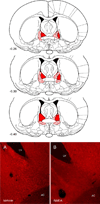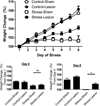Excitotoxic lesions of the bed nucleus of the stria terminalis (BNST) attenuate the effects of repeated stress on weight gain: evidence for the recruitment of BNST activity by repeated, but not acute, stress
- PMID: 22101300
- PMCID: PMC3242928
- DOI: 10.1016/j.bbr.2011.11.010
Excitotoxic lesions of the bed nucleus of the stria terminalis (BNST) attenuate the effects of repeated stress on weight gain: evidence for the recruitment of BNST activity by repeated, but not acute, stress
Abstract
Exposure to repeated stress can lead to diverse and widespread behavioral consequences, including reduction in food and water intake and subsequent diminution in weight gain. Many reports have suggested that repeated stress substantially alters the neurochemistry, morphology and physiology of neurons within the bed nucleus of the stria terminalis (BNST). Here we investigate the role of the BNST in mediating the reduced weight gain observed during repeated stress. Rats exposed to a one-week variate stress paradigm exhibited a reduction in weight gain over the course of the 7-day paradigm. Excitotoxic lesions to a subregion of the anterolateral BNST containing the oval nucleus had no effects early in the 7-day paradigm, but significantly attenuated the effects of repeated stress on weight gain by the last day of stress. These data suggest that at least two mechanisms mediate the effects of stress on body weight gain, and that when stressor exposure becomes repeated, the BNST is recruited, worsening the symptoms of stressor exposure.
Copyright © 2011 Elsevier B.V. All rights reserved.
Figures


Similar articles
-
PAC1 receptor antagonism in the bed nucleus of the stria terminalis (BNST) attenuates the endocrine and behavioral consequences of chronic stress.Psychoneuroendocrinology. 2014 Sep;47:151-65. doi: 10.1016/j.psyneuen.2014.05.014. Epub 2014 May 27. Psychoneuroendocrinology. 2014. PMID: 25001965 Free PMC article.
-
PACAP in the BNST produces anorexia and weight loss in male and female rats.Neuropsychopharmacology. 2014 Jun;39(7):1614-23. doi: 10.1038/npp.2014.8. Epub 2014 Jan 17. Neuropsychopharmacology. 2014. PMID: 24434744 Free PMC article.
-
Roles for pituitary adenylate cyclase-activating peptide (PACAP) expression and signaling in the bed nucleus of the stria terminalis (BNST) in mediating the behavioral consequences of chronic stress.J Mol Neurosci. 2010 Nov;42(3):327-40. doi: 10.1007/s12031-010-9364-7. Epub 2010 Apr 20. J Mol Neurosci. 2010. PMID: 20405238 Free PMC article. Review.
-
Chronic Stress Induces Maladaptive Behaviors by Activating Corticotropin-Releasing Hormone Signaling in the Mouse Oval Bed Nucleus of the Stria Terminalis.J Neurosci. 2020 Mar 18;40(12):2519-2537. doi: 10.1523/JNEUROSCI.2410-19.2020. Epub 2020 Feb 13. J Neurosci. 2020. PMID: 32054675 Free PMC article.
-
The intersection of stress and reward: BNST modulation of aversive and appetitive states.Prog Neuropsychopharmacol Biol Psychiatry. 2018 Dec 20;87(Pt A):108-125. doi: 10.1016/j.pnpbp.2018.01.005. Epub 2018 Jan 9. Prog Neuropsychopharmacol Biol Psychiatry. 2018. PMID: 29330137 Review.
Cited by
-
VGluT3 BNST neurons transmit GABA and restrict feeding without affecting rewarding or aversive processing.bioRxiv [Preprint]. 2025 Jan 2:2025.01.01.631003. doi: 10.1101/2025.01.01.631003. bioRxiv. 2025. Update in: Mol Metab. 2025 Aug;98:102178. doi: 10.1016/j.molmet.2025.102178. PMID: 39803518 Free PMC article. Updated. Preprint.
-
Parabrachial nucleus (PBn) pituitary adenylate cyclase activating polypeptide (PACAP) signaling in the amygdala: implication for the sensory and behavioral effects of pain.Neuropharmacology. 2014 Nov;86:38-48. doi: 10.1016/j.neuropharm.2014.06.022. Epub 2014 Jul 3. Neuropharmacology. 2014. PMID: 24998751 Free PMC article.
-
PAC1 receptor antagonism in the bed nucleus of the stria terminalis (BNST) attenuates the endocrine and behavioral consequences of chronic stress.Psychoneuroendocrinology. 2014 Sep;47:151-65. doi: 10.1016/j.psyneuen.2014.05.014. Epub 2014 May 27. Psychoneuroendocrinology. 2014. PMID: 25001965 Free PMC article.
-
The PACAP/PAC1 Receptor System and Feeding.Brain Sci. 2021 Dec 23;12(1):13. doi: 10.3390/brainsci12010013. Brain Sci. 2021. PMID: 35053757 Free PMC article. Review.
-
The PACAP Paradox: Dynamic and Surprisingly Pleiotropic Actions in the Central Regulation of Energy Homeostasis.Front Endocrinol (Lausanne). 2022 Jun 1;13:877647. doi: 10.3389/fendo.2022.877647. eCollection 2022. Front Endocrinol (Lausanne). 2022. PMID: 35721722 Free PMC article. Review.
References
-
- Buwalda B, Van Kalkeren AA, de Boer SF, Koolhaas JM. Behavioral and physiological consequences of repeated daily intracerebroventricular injection of corticotropin-releasing factor in the rat. Psychoneuroendocrinology. 1998;23:205–218. - PubMed
-
- Choi DC, Nguyen MM, Tamashiro KL, Ma LY, Sakai RR, Herman JP. Chronic social stress in the visible burrow system modulates stress-related gene expression in the bed nucleus of the stria terminalis. Physiology & Behavior. 2006;89:301–310. - PubMed
-
- Choi DC, Furay AR, Evanson NK, Ulrich-Lai YM, Nguyen MM, Ostrander MM, Herman JP. The role of the posterior medial bed nucleus of the stria terminalis in modulating hypothalamic-pituitary-adrenocortical axis responsiveness to acute and chronic stress. Psychoneuroendocrinology. 2008b;33:659–669. - PMC - PubMed
MeSH terms
Substances
Grants and funding
LinkOut - more resources
Full Text Sources
Medical

